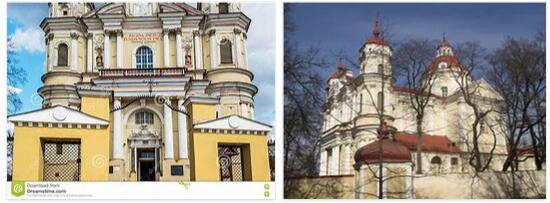
Lithuania is extensively covered by forests and is therefore ideal for long hiking tours. The Baltic coast awaits holidaymakers with many spa and bathing resorts. The main attraction of the country is the capital Vilnius. In the cultural center of Lithuania you will discover the baroque church of St. Peter and Paul, the Ausros Vartei city gate with the Chapel of the Dawn, the old university and the Orthodox cathedral. The main attraction is the castle hill with the Gediminasturm, from which you have a panoramic view of the city and the Neris river. You can also visit the cities of Kaunas with the historic town hall, the Ciurlionis Museum, the Devil Museum, the Kaunas Cathedral; Klaipeda with the Simon-Dach-Brunnen with Ännchen von Tharau, the Theaterplatz; the city of Alytus or Jonava with the regional museum and numerous music bands. Take a study trip through Lithuania!
Gediminas Tower
A visit to the capital Vilnius and its famous landmark, the Gediminas Tower, is a must for every study trip to Lithuania. It towers above the village on the 140 meter high castle hill and is the only remaining part of a stately defensive system from the 14th century.
The legend of Vilnius
According to legend, the Grand Duke Gediminas fell asleep on a hill after a strenuous hunt near today’s city of Vilnius. He dreamed of a huge iron wolf standing on the top of the mountain on which he had successfully killed an animal that day. The wolf howled as loudly as if it had united a hundred wolves. Gediminas had this dream interpreted by a shaman, who prophesied to the prince that he would build a strong castle exactly at this point, in the shadow of which a mighty city, fortified with thick walls, would emerge. The Grand Duke followed the prophecy, had a castle built on the mountain and thereby founded Vilnius.
The history of the castle
The fortress was built in 1323 by its namesake Gediminas, probably not because of a dream, but for strategic reasons. It consisted of a total of three castles, which were repeatedly subjected to violent attacks by the crusaders. One of the three castles burned down as early as 1390, but the others successfully defended themselves. When the entire complex was captured and heavily destroyed in 1655, it fell into disrepair and was never rebuilt even after it was reconquered. The only part that remains in the original is a corner tower made of red bricks.
Today the Gediminas Tower houses a history museum and can be reached either on foot via steps or by funicular. A visit to the 70-meter-high viewing platform is rewarded with a wonderful panoramic view of the historic city of Vilnius, which is well worth a visit with its numerous sights.
Peter and Paul Church Vilnius
The Church of St. Peter and Paul of Vilnius was built between 1668 and 1675. As a baroque church, it is particularly impressive in the interior. It looks bright, flooded with light and magnificent. The Polish architect Jan Zaor was initially responsible for the plans, then the architect Giambattista Frediani from Italy was responsible for the last four years of construction. The cathedral is one of the impressive sights of the Lithuanian capital Vilnius.
Light and friendly interior
The high dome at the intersection of the cross-shaped floor plan ensures a friendly brightness of the interior. The high quality white stucco work comes from Pietro Perti from Ticino and Giovanni Maria Galli from Bologna. Despite the abundance of different ornaments and figures, the viewer does not lose orientation when looking at the various motifs, which by no means only depict religious content, but also scenes from everyday life.
Historical origin
As a Catholic baroque church, St. Peter and Paul is an impressive alternative to the rather image-hostile Reformation. At the same time, the building, which looks almost inconspicuous from the outside, symbolizes Lithuania’s claim to autonomy vis-à-vis Russia. The church was commissioned by the then political leader (hetman) Michael Kasimir Pac, in commemoration of the liberation of Lithuania from the Russians.
The approximately 2000 stucco figures symbolize on the one hand the power of God, whose face is depicted in the dome, but on the other hand also the will of the Lithuanians to assert themselves against their overpowering neighbor Russia. This attraction is definitely worth a visit.
Location outside the old town
The church is not directly within the old town of Vilnius. The baroque building replaced a wooden church from the beginning of the 17th century, which was destroyed by the Russian occupiers in 1655. Originally, the temple of the pagan Milda, a goddess of love, was located on the square.